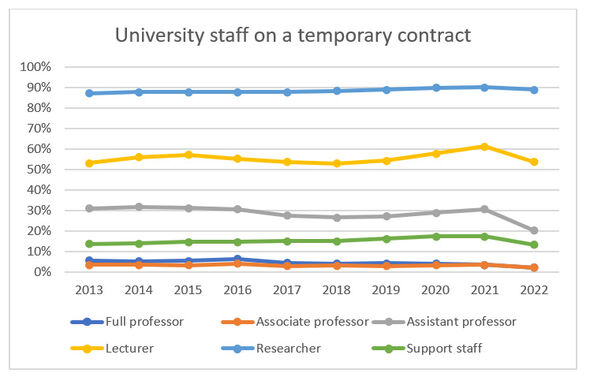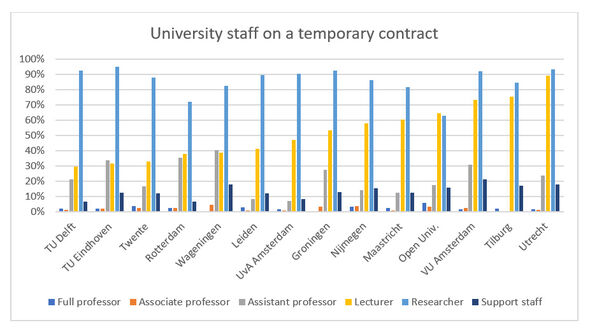
- The University , Employee
- 04/09/2023
Unions and action groups are protesting at Vrije Universiteit Amsterdam today. Amongst other things, they are critical of the many temporary contracts in academia and the related problems involving social safety.
Also today, on the occasion of the start of the new academic year, universities are putting out a euphoric press release, in which they report a “significant increase” of the number of permanent contracts.
Turnaround
The new figures confirm we are in the middle of a turnaround. Last year, 62 percent of the lecturers without any research tasks had a temporary position. This figure is now 54 percent (just above the 2018 level).
Assistant professors are also on a temporary contract significantly less often (down from 29 to 19 percent). Finally, support staff are also slightly more likely to be permanently employed.
Differences
The differences between universities, however, are still massive. At Delft University of Technology, nearly 30 percent of lecturers are on temporary contracts, compared to 89 percent at Utrecht University. In Wageningen, 40 percent of assistant professors have a temporary contract. According to the most recent tables, that figure is zero percent at Tilburg University.
All PhD candidates are on temporary contacts, whereas almost all full professors and associate professors are permanently employed. This hasn’t changed.
“Over the past few years, universities have made an effort to increase the share of permanent contracts”, umbrella organisation Universities of The Netherlands (UNL) states. “Recent investments by the government, through sectoral plans and starting and incentive grants, also contribute to fewer flexible and more permanent contracts.”
Even more temporary contracts
The trend isn’t as visible at all universities. For lecturers and researchers in Utrecht nothing much has changed, with the local university giving out the highest number of temporary contracts to this group by far. At Vrije Universiteit Amsterdam, even more lecturers and researchers are on temporary contracts than last year. Tilburg, Nijmegen, Groningen and Eindhoven aren’t showing any major changes either.
Erasmus University Rotterdam, on the other hand, has cut the share of temporary contracts for lecturers and assistant professors in half, putting them at 37 and 29 percent respectively. For researchers, this figure went down from 95 to 69 percent.
UNL’s annual figures are based on the personnel files of 31 December, which means the newest figures are actually eight months old.
Incidentally (and rather confusingly), the tables also include a relatively small group of other academic staff that hasn’t been classified as teaching staff or researchers. At some universities they all have temporary contracts, whereas at other ones almost all of them are permanently employed. And there are also some universities that don’t have this category at all.


Discussion